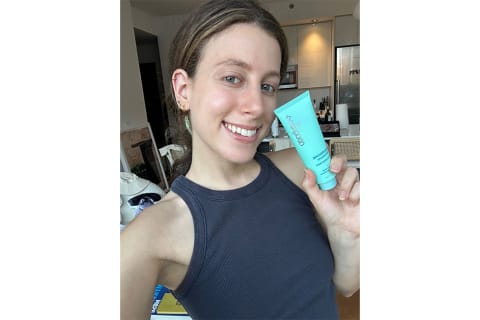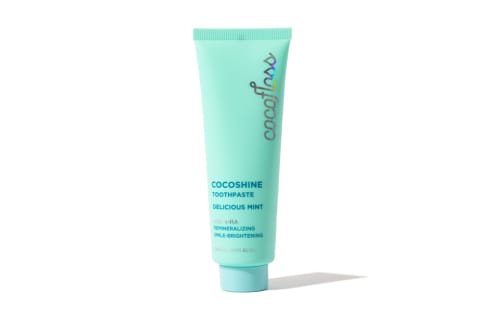Cocoshine Is The Only Whitening Toothpaste That Has Actually Transformed My Smile


I have super-sensitive teeth. I won't bore you with all the details, but I struggle with gum recession that causes the tissue to pull away from my teeth, exposing the fragile roots underneath. It's genetic, so I'm prone to that sensitivity even though I treat my teeth and gums with painstaking care. Just my lot in life!
Here's the thing, though: I also crave a whiter smile. I desperately want to wow everyone I meet with a dazzling set of pearly whites, but my poor gums can barely handle most teeth-whitening products. Even cleaner formulas often make me wince in pain, so a brilliant white smile always felt like a pipe dream—or at least it did.
The formula
If you haven't yet considered making the switch to natural toothpaste, riddle me this: If you use a sulfate-free shampoo and face wash in the name of hair and skin health, why treat your pearly whites any differently?
See, traditional pastes often contain sodium lauryl sulfate (or SLS), which is what gives them that quintessential, foamy mouthfeel. And just like how sulfates can strip your skin and hair of precious moisture, they can potentially irritate your soft oral tissue1 and disrupt the microbiome—some experts say this can even lead to chronic bad breath in the long run!
Another common toothpaste ingredient is hydrogen peroxide, which you can find in plenty of traditional whitening formulas, as it's been clinically shown to brighten up teeth (just like the solution can bleach fabrics).
However, many people claim it can make your teeth sensitive, and preliminary research has found that it can penetrate the enamel and potentially degrade the proteins in this layer (which may explain the sensitivity). It also has the ability to disrupt your oral microbiome, as it's incredibly antibacterial.
For these reasons, Cocoshine remains completely sulfate- and peroxide-free. But that doesn't mean it won't result in a brighter smile: Rather, the formula calls on nanocrystals of hydroxyapatite (n-HA), a mineral that makes up 97% of teeth's enamel.
Studies have shown that n-HA can penetrate below the tooth's surface2 to effectively remineralize and strengthen teeth (as opposed to fluorides, which remineralize on the surface). And guess what? Stronger teeth and gums appear way less dingy.
But n-HA has some specific whitening properties3 as well: "n-HA deeply repairs microcracks and defects in your teeth4, filling them with opaque, white hydroxyapatite crystals, so your enamel is smoother, more lustrous, and more reflective to light," says dentist Chrystle Cu, DDS, co-founder of Cocofloss. "The result: a whiter, shinier, more radiant smile from the inside out."
In other words, the ingredient helps restore teeth and prevent sensitivity while whitening the surface—perfect for someone like me with weaker enamel. And Cocoshine contains a whopping 3% of n-HA, one of the highest concentrations in the oral care game.
In addition to that MVP ingredient, Cocoshine includes microbiome-balancing xylitol, coconut oil, and aloe vera—which boasts natural brightening abilities. It also relies on baking soda and silica to gently buff and remove surface stains, instead of coarser abrasives that can damage enamel.
The experience
I've tried my fair share of natural toothpastes—I even wrote a roundup to discover the best of the best—but I'll admit I have yet to stick with a cleaner option. After committing to a natural tube for a few weeks, I end up missing the foamy mouthfeel and fresh, clean feeling that comes with a more traditional formula. So I end up reverting to a sulfate-laden paste.
Since using Cocoshine, however, I haven't even thought about my traditional tube—it now sits in the way back of my bathroom cabinet. That's because Cocoshine foams up way better than other clean pastes—still not as much as one that uses sulfates but definitely more than any other natural toothpaste I've tried.
It also tastes good. Like, really good. I'm more of a mint girl—bubblegum or strawberry tends to taste way too saccharine—so the "Delicious Mint" flavor is my go-to, but the "Lychee Breeze" tastes way more elevated than other traditional toothpaste flavors, with just a hint of sweetness.

My results
Finally, the results we've both been waiting for. I can confidently say that Cocoshine has made my teeth appear way less dull. My smile looks shinier, my gums look healthier, and most importantly, my teeth feel stronger.
No more wincing every time I take a sip of an ice-cold drink or avoiding certain areas while I brush. My gums feel more comfortable with each passing day, and I know I have Cocoshine to thank.
Will it give you instantly transformative results like an in-office whitening session? No, it will not. The whitening toothpaste takes time and consistency to actually, well, work. But over time, you will start to see your smile naturally look brighter.
Before you know it, you'll wake up one day and think, Huh, my teeth do look extra sparkly. Consider it a gift from the Cocofloss tooth fairy.
The takeaway
One tube of Cocoshine costs $22, which is a bit pricey for a personal care item you might have haphazardly chucked into your cart at the drugstore. But quality n-HA is very expensive to source right now, Cu tells me, especially at such high concentrations. "The lab must be able to create these very small particles—currently a more expensive process than producing fluoride for toothpaste," she notes.
Until n-HA becomes as mainstream as fluoride, you might have to shell out more cash for the cleaner option. Take it from me, though, the dazzling results are well worth it.

Jamie Schneider is the Beauty Editor at mindbodygreen. She has a B.A. in Organizational Studies and English from the University of Michigan, and her work has appeared in Coveteur, The Chill Times, and more. In her role at mbg, she reports on everything from the top beauty industry trends, to the gut-skin connection and the microbiome, to the latest expert makeup hacks. She currently lives in Brooklyn, New York.
4 Sources
- https://pubmed.ncbi.nlm.nih.gov/8653493/
- https://www.nature.com/articles/s41405-019-0026-8?utm_medium=affiliate&utm_source=commission_junction&utm_campaign=CONR_PF018_ECOM_GL_PHSS_ALWYS_DEEPLINK&utm_content=textlink&utm_term=PID100090071&CJEVENT=39c2cc641ab211ee819e78340a1cb827
- https://www.ncbi.nlm.nih.gov/pmc/articles/PMC9955010/
- https://www.ncbi.nlm.nih.gov/pmc/articles/PMC9955010/figure/dentistry-11-00050-f002/
